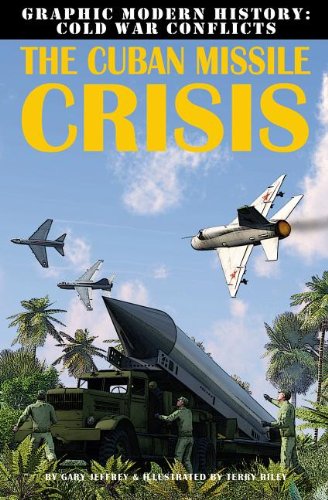-
The Cuban Missile Crisis
Gary Riley Jeffrey
Paperback (Crabtree Publishing Company, Nov. 15, 2013)In graphic novel format, introduces the Cuban Missile Crisis of 1962. T
T
-
The Cold War and the Cuban Missile Crisis
Natalie Hyde
Paperback (Crabtree Publishing Company, March 1, 2016)Through a lens of primary sources, this intriguing title looks at the pivotal crisis from the Cold War during which the Soviet Union set up nuclear missiles in Cuba. Well-crafted text and engaging sources introduce readers to the key players, including Castro, Khrushev, and Kennedy and examine the intricacies of the crisis including proxy wars, communication systems, and the outcome. A final chapter examines relations today and explores the idea that a new Cold War with Russia may be looming. X
X
-
The Cuban Missile Crisis
Charlie Samuels
Paperback (Gareth Stevens Classroom, Jan. 1, 2014)Examines the October 1962 Cuban Missile Crisis, the Cold War standoff in which the United States and the Soviet Union--and the world--narrowly escaped nuclear war. W
W
-
The Cuban Missile Crisis
Charlie Samuels
Library Binding (Gareth Stevens Publishing, Jan. 1, 2014)In 1962, people around the world, but especially in the United States, Cuba, and the Soviet Union, seemed to be holding their breath as they wondered if a nuclear war was about to erupt. US Secretary of Defense Robert McNamara later recalled that he thought October 27, 1962, "was the last Saturday I would ever see." This notable book, packed with interesting sidebars and fascinating facts, transports readers back to a time of political intrigue. Key figures such as John F. Kennedy, Fidel Castro, and Nikita Khrushchev are examined as well as related events such as the Bay of Pigs. W
W
-
The Cuban Missile Crisis
Gary Jeffrey, Terry Riley
Library Binding (Crabtree Pub Co, March 30, 2014)In graphic novel format, introduces the Cuban Missile Crisis of 1962. T
T
-
The Cuban Missile Crisis
Myra Immell
Hardcover (Greenhaven Press, Sept. 10, 2010)Each volume opens with background information -- including primary source material -- covering the periods leading up to, during and after the event. Then, each volume offers an in-depth, multinational perspective on the controversies surrounding the event and the current implications or long-lasting effects. Each volume concludes with first-person narratives from people who lived through or were directly impacted by the event.
-
The Cuban Missile Crisis
Peter Chrisp
Library Binding (World Almanac Education, Dec. 1, 2001)Looks at the Cuban Missle Crisis from both the side of the United States and the Soviet Union, including the Bay of Pigs, the Berlin Wall, and the rise of Fidel Castro's Cuba.
-
The Cuban Missile Crisis
Helga Ph D Schier
Library Binding (Essential Library, Jan. 1, 2008)Describes the political and military buildup of pressure that led to the Cuban Missile Crisis, discussing the Cold War, Castro's revolution, the Bay of Pigs invasion, and the arms race between the United States and the Soviet Union.
-
The Cuban Missile Crisis
Catherine Hester Gow
Library Binding (Lucent Books, March 1, 1997)Examines the events preceding, during, and after the confrontation between the United States and Cuba over the presence of Soviet missiles there
-
The Cuban Missile Crisis
Nathaniel Harris
Hardcover (Hodder & Stoughton, Nov. 1, 2002)This book looks at the Cuban Missile Crisis through what the newspapers of the time reported. It uses a range of contemporary articles, including those from American newspapers, to allow the reader to see how the Crisis was perceived at the time. Each article is put in historical context, and the causes and significance of what happened are explained with the benefit of hindsight. Evaluation boxes look at the articles as historical evidence for understanding the Cuban Missile Crisis, and discuss how the same event can be reported in different ways. S
S
-
The Cuban Missile Crisis
Heather Lehr Wagner
Library Binding (Chelsea House Pub (Library), Aug. 1, 2011)For 13 days in October 1962, the United States came closer than it ever had to nuclear war with the Soviet Union. In retaliation for the U.S. placement of missiles near the Soviet border in Europe, the Soviet Union placed missiles on Cuba, a mere 90 miles from U.S. soil. In the 13 heated days that followed, U.S. President John F. Kennedy and Soviet leader Nikita S. Khrushchev successfully negotiated a peaceful end to the missile standoff that had led the world to the brink of nuclear war a war that would have undoubtedly devastated both countries. The Cuban Missile Crisis explores the dramatic developments of those 13 days, from the time the United States first learned of the USSR's nuclear missiles in Cuba to the steps taken to ensure that those missiles were never fired. Y
Y
-
The Cuban Missile Crisis
E.J. Carter
Library Binding (Heinemann, Oct. 13, 2003)What was the Cuban Missile Crisis? -- From Revolution to Totalitarianism -- The Cold War -- Castro and the Cuban Revolution -- JFK and the Election of 1960 -- Disaster at the Bay of Pigs -- Sparring in Vienna and Berlin -- Arming Cuba -- Ex Comm -- Invasion vs. blockade -- Going public -- Diplomacy -- Eyeball to eyeball -- The Jupiters -- A possible solution -- New tensions -- The secret missile swap -- Doomsday scenarios -- Changing historical evaluations -- 1989 -- Timeline. Y
Y